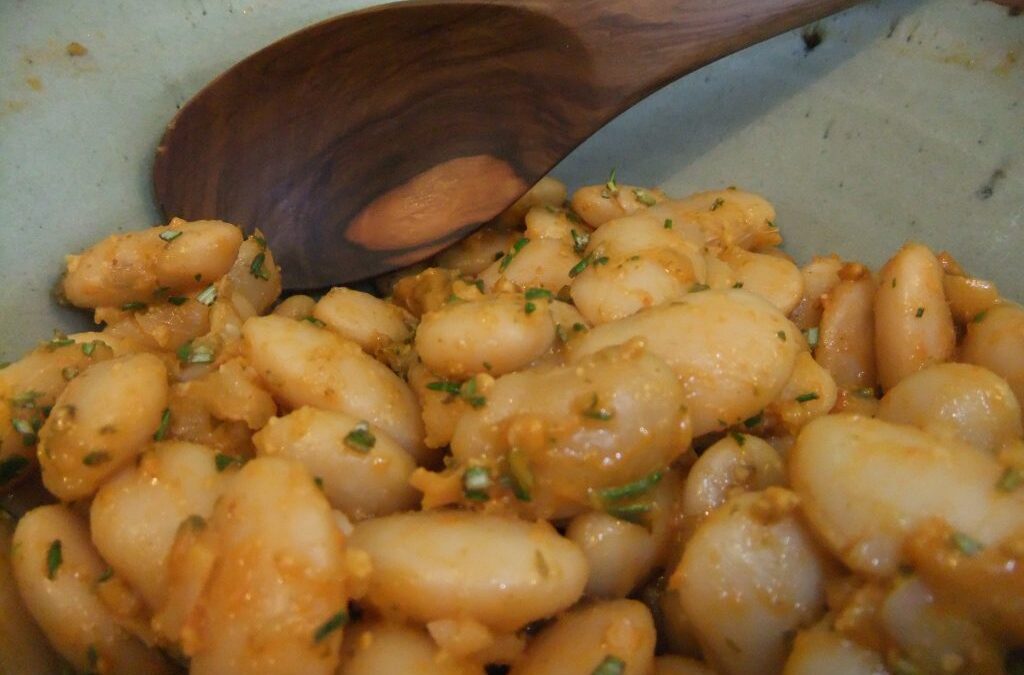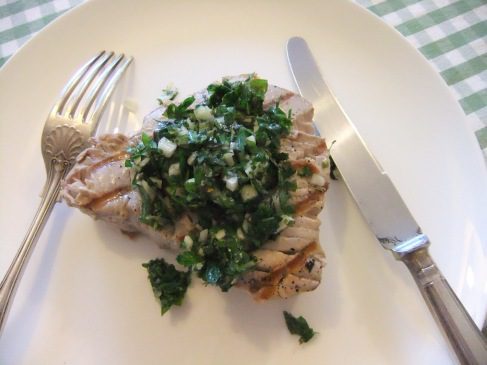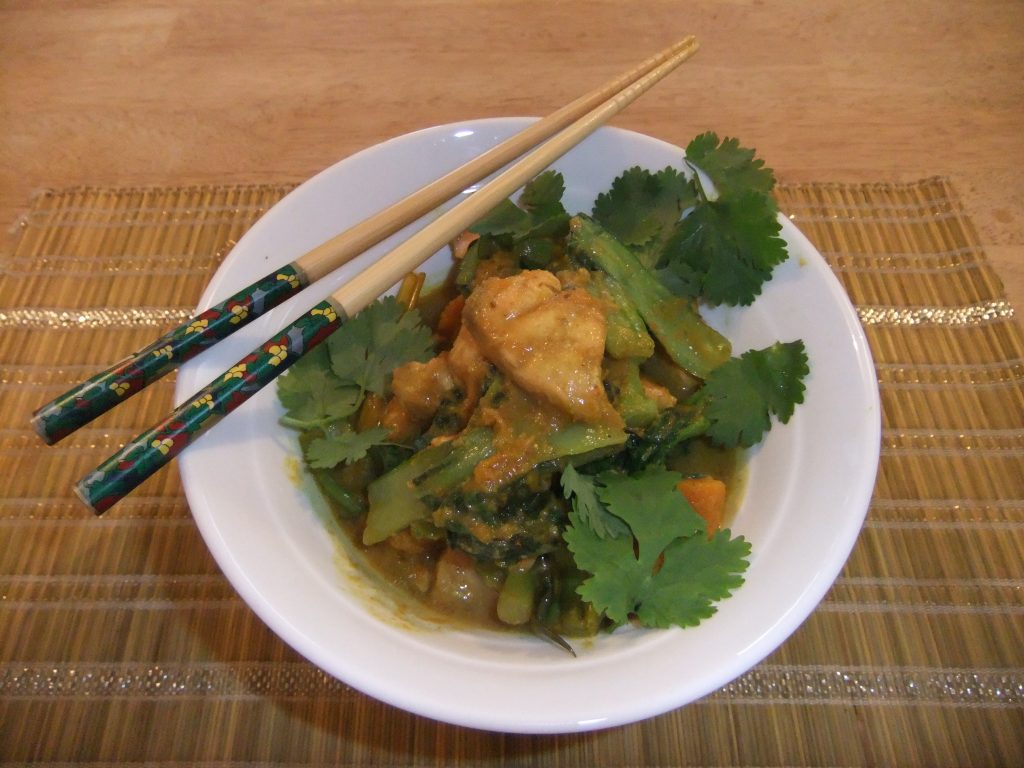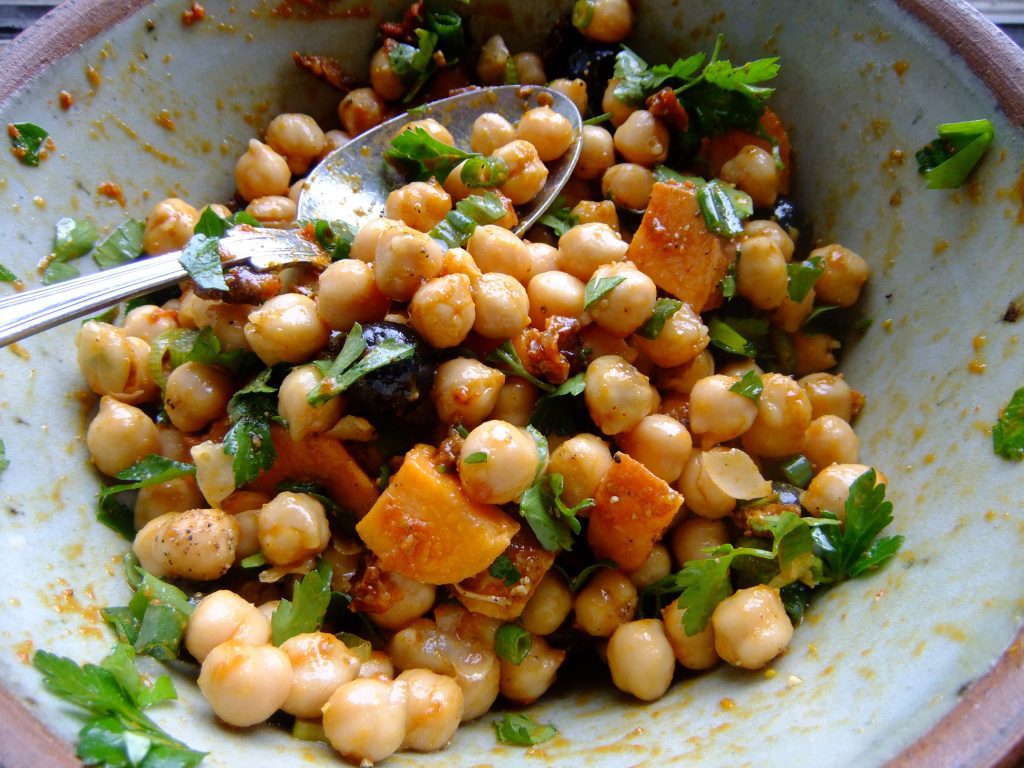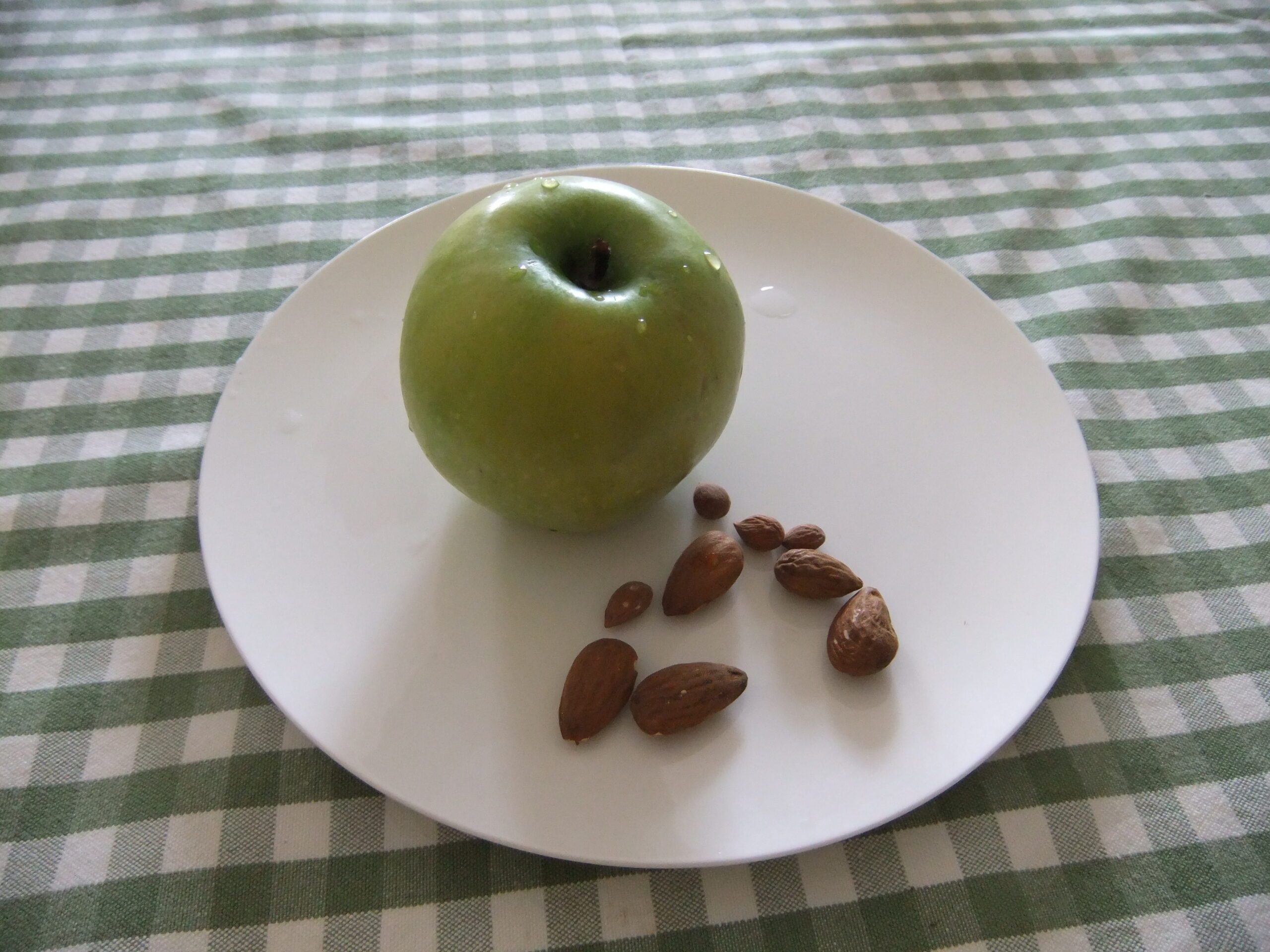
Aug 6, 2013 | Anna's Best Recipes, Main courses, Sides, starters, soups & snacks
This is something delicious I make when I’m in a hurry and need some good quality protein. It works well with a simple mixed salad on the side to make a balanced meal. You could also substitute it for potatoes alongside meat or white fish. I usually make lots so we can use the leftovers for packed lunches.
Serves 4 (or 2 with leftovers)
1 heaped dsp sun-dried tomato pesto
One of the following fresh herbs if you have them, chopped:
Rosemary leaves: 1 tsp/oregano 1 tbs/parsley 1 tbs
2 dsp lemon juice
2 tins or mugs of cooked butter beans, drained
1 clove garlic, crushed (optional)
Black pepper
- Mix the lemon juice, pesto, garlic, and herbs together in a bowl.
- Add butterbeans, a few good grinds of black pepper, and mix well. Taste and if you feel like it, add more lemon juice, pesto, or pepper.
- Eat with a large mixed salad such as my “basic mixed salad”.
Why this recipe is good for you:
Beans and pulses are rich in soluble fibre, a type of fibre that feeds friendly bacteria in your gut. Friendly bacteria are important for your immune system, helping regulate it and prevent allergies such as eczema and inflammatory diseases such as colitis. These good bacteria also help your body clear toxins. Toxins we are commonly exposed to include used-up hormones (eg estrogens, testosterone), old medications, and chemicals (eg toxic nitrites from processed meat, petrochemicals from toiletries, and petrol fumes). So if you want to have good detoxification, clear skin, and tune up your digestion, fostering your good gut bacteria is one of the keys. Rosemary, oregano, lemon juice, and garlic are also great helpers for the liver, also promoting fast efficient clearance of toxins.

Aug 5, 2013 | Anna's Best Recipes, Desserts & drinks
We ate this for dessert last night, and I indulged again after a full breakfast this morning so am sitting here feeling a bit stuffed! This delicious mostly cake is very decadent and has a lot of good-for-you stuff. Technically its not all raw as cashew nuts are steamed after harvesting to make them edible. You can make this up to 5 days ahead if you like. The recipe is adapted from one by Laura Wright but I have reduced the syrups and given you alternatives for those hard-to-find ingredients. I also use cooked beetroot instead of raw, which simply doesnt break up well unless you have a super high speed food processor. Sometimes I make individual servings in mousse rings and store in a box in the freezer. I find that this cake quantity makes at least 10 so sometimes I make half the quantity for a smaller gathering.
It’s really important to use the mousse ingredients at room temperature not straight from the fridge – otherwise it solidifies instantly into an un-pourable mound with a grainy texture. I found out this by experience!!
For 1 x 22cm cake (to serve 10-12):
Remember to check out “larder & shopping” section in this blog for suppliers
Base:
310g raw almonds
30g raw cacao powder
¼ level tsp Himalayan or Atlantic Sea Salt
40g dried sour cherries (or use dried cranberries if you can’t get cherries)
8 medjool dates, pitted
1 tsp vanilla extract
1 rounded tbsp extra virgin coconut oil
Mousse:
325g raw cashews, soaked overnight in filtered water, at room temperature
330ml almond milk, at room temperature
155ml/140g extra virgin coconut oil, gently warmed to a liquid
60ml/4 level tbs/85g raw honey, raw agave nectar or maple syrup, at room temperature (tip: use a hot spoon to measure honey, if using)
Juice of 1 lemon, at room temperature
2 tsp vanilla extract
¼ level tsp Himalayan or Atlantic Sea Salt
115g frozen, pitted cherries (or raspberries if you prefer), thawed, at room temperature – or use pitted fresh cherries if in season
1 small cooked beetroot, chopped, at room temperature (shop bought will do)
1 x 22cm spring-form cake tin
A little extra coconut oil for greasing the tin
A food processor
Cling film (if making ahead and storing in the freezer)
1. To make the base, place the almonds in a food processor and pulse until chopped and resembling breadcrumbs. Add the cacao powder, salt, dried sour cherries, dates, vanilla and rounded tbsp coconut oil and blitz until the dried fruit is evenly distributed throughout the mix. When the mixture holds together when pinched, it’s ready to use. Grease the sides of your tin with a little extra coconut oil or rapeseed oil. Evenly press the base mix into the bottom of the prepared tin and set aside.
2. To make the mousse, remember that all the ingredients need to be at least at room temperature or else the mix thickens too quickly and becomes grainy and unpourable. Drain the cashews and combine them in the food processor with the almond milk, coconut oil, honey/maple syrup or agave, lemon juice and salt. Blend until smooth.
3. Pour all but 500ml (about half) of the mixture into the prepared tin. Add the pitted cherries and chopped beetroot to the remaining 500ml of the mixture. Blend until smooth and pour all but 250ml of this mixture quickly into the centre of the cake. Lightly drizzle the remaining mousse mixture around the top of the cake creating a decorative marbled effect.
4. To set the mousse cake: cover the tin with a plate and place in the coldest (bottom) shelf of the fridge for 6 hours or overnight. Alternatively, stretch cling film over the top of the tin and slide gently into the freezer for 6 hours or overnight. The cake will keep quite happily for a couple of weeks in the freezer. Remove from the freezer to thaw at room temperature for 1-2 hours before serving. When its soft right the way through (test with a needle), place in the fridge until you want to serve.
Dietary note:
Virgin coconut oil is a great source of medium chain triglycerides, a special type of fat that goes straight into energy production in your body instead of being used to make fat. For this reason, it is a healthier fat than butter. Coconut oil also contains capryllic acid, which has anti-fungal properties – good news for anyone with bowel issues or cystitis linked to candida. Cherries, red berries and beetroots are high in proanthocyanadins which strengthen connective tissue and the lining of your digestive system, reducing the tendency to diverticulitis, hernias and saggy skin. Raw almonds (and cold-pressed or “extra virgin” oils) contain vitamin E. This vitamin naturally lubricates and moisturises your skin, reduces the production of wrinkles, and also helps dampen down allergic reactions. Healthy skin does not need body moisturisers. “Raw” cashew nuts are, bizarrely, not raw at all – the nuts have to be steamed in order to be extracted from their hard shell. Cashews are a sweetish and healthier substitute for cream cheese, sugar and other not-so-great ingredients that tend to be used in desserts. Desserts like this one should be used as occasional treats and not eaten at every meal. They are still rich in natural sugars and if you eat them all the time, provide more calories than you need. A normal daily intake of raw nuts and seeds would not exceed a tablespoon or two.

Jul 30, 2013 | Anna's Best Recipes, Breakfasts & smoothies, Main courses
This was one of my favorite breakfasts on a weekday when I didn’t have that much time and I didn’t have to be gluten-free. Now that I know I’m coeliac I use the gluten-free alternatives mentioned below. Cooking in the oven makes it handy, because (unlike grilling) you don’t have to watch it every minute. These Taifun brand sausages are vegan and contain 11% protein so are great for keeping you satisfied for longer. Check out my “larder” on the menu for where to buy these and other unusual foods. Make sure you get the “grill herb sausages” though, they are the nicest. These sausages are not gluten-free as they contain soya sauce and small amounts of oats (which can be contaminated with gluten grains). For the gluten-free option, see the Taifun Basil Tofu option below in the recipe. You could also eat this for a light lunch or dinner. All the Taifun products keep for ages in the fridge.
For 1 person:
1 tomato
1 medium courgette
2 Taifun grill herb sausages (these contain gluten, for gluten-free- slice 1/2 a block of Taifun Basil Tofu or Tofu Rosso into 3 thick slices instead)
Extra virgin olive oil
1 tsp dried oregano or 1 tbsp chopped fresh oregano
Freshly ground black pepper
- Put the sausages on a baking sheet in the oven and switch on to 170C (or 150C in a fan oven). Wash the courgette and tomato. Halve the tomato and slice the courgette lengthways – sliced 1/2-2/3 cm thick is just about right, I think.
- Leave the sausages to cook in the heating-up oven for around 25-30 minutes while you shower or generally get ready for the day.
- After 25 mins remove the baking sheet from the oven. The sausages or basil tofu should be swollen up and slightly coloured now. Add the courgette slices and tomato halves and pop into the oven for another 5 minutes. This way the veggies will be hot but not mushy. They will retain lots of nutrients this way.
- Arrange everything on a plate, drizzle a teaspoon of olive oil over the courgette slices, sprinkle the oregano over the tomatoes, and add a few good grinds of black pepper. Why this recipe is good for you:
The oregano and tomatoes in this recipe are packed with antioxidants that help your health – by lowering inflammation, delaying ageing, and (in the case of oregano) inhibiting the growth of pathogenic (“bad”) organisms in the gut. Research suggests that unfermented soya products (eg soya milk, textured soya vegetable protein) are not likely to be helpful to health whereas traditional products that are fermented (fermented tofu, tempeh, miso, natto) have lots of evidence to support usefulness in adult hormonal health, especially in relation to breasts and prostate. Fermented soya products are an excellent source of high-quality protein to keep you feeling fuller for longer. If you have autoimmune conditions though, you may need to avoid soya products.

Jul 16, 2013 | Anna's Best Recipes, Main courses
This is inspired by a very simple treatment of a steak that I once ate in sunny Amalfi. It was so fresh and zingy I loved it and tried to recreate the taste when I got home. We also use the gorgeous herb-and-garlic topping for a venison steak or a piece of lean sirloin, simply done on a barely-oiled pan. The herbs you use in addition to the parsley depend on what’s convenient for you to buy or pick from your garden.
For 2:
2 tuna steaks, about 120g each (about the size of your palm)
1 small handful of parsley (flat-leaf is nice if you can get it)
A sprig (about 8-10cm long) of rosemary, 3-4 sprigs of thyme, or a handful of oregano sprigs (or all 3 if you are lucky enough to grow your own herbs and have a plentiful supply)
2-3 cloves garlic
Extra virgin olive oil
Freshly ground black pepper
A pinch of Himalayan or Atlantic Sea Salt
To serve: a large mixed salad, with dressing, or 350g steamed French or runner beans
- First of all, wash and dry your herbs and destalk them. you will want, in total about 3 tablespoons of chopped herbs. Then chop as finely as you can manage. The finer the herbs, the less chewy the topping will be. Peel and chop the garlic cloves as finely as you can manage. Add the chopped herbs and garlic to a bowl, season with a few good grinds of black pepper, a pinch of salt, and enough extra virgin olive oil to wet the whole thing so it sticks together a bit. Mix and set aside.
- Prepare your salad or put your beans on to steam before cooking the tuna steaks.
- Heat a heavy-bottomed frying pan or griddle pan. Oil it lightly using some macadamia or olive oil, just enough to get a non-stick film on the pan but not enough to see an oil slick.
- On medium heat, cook the steaks for around 4-5 minutes on each side (it depends on the thickness of the steak). It’s ok to leave fresh tuna a little pink in the middle and it’s moister and more delicious that way.
- Once the steaks are done, slide onto warm plates and pile the garlic-herb mix on top of each one.
- Serve with the salad or steamed French or runner beans.
Dietary note:
Fresh (not tinned) tuna is a great source of omega 3 oils. Garlic and herbs contain potent antioxidants which also enhance many functions in the body, from dampening down inflammation and allergies to boosting liver function. Regularly eating fresh herbs, garlic and oily fish has positive effects on mood, skin health, and digestive wellness. The raw extra virgin olive oil used here is a source of vitamin E which is also anti-inflammatory and anti-ageing. People adding olive oil, raw nuts, and raw seeds to their diet lose weight, according to scientific research.

Jul 15, 2013 | Anna's Best Recipes, Main courses
We love this warming, comforting curry when the weather is grey and cold and guests always seem to love it. My husband adapted it from a recipe by Nigella to have a thicker sauce, more greens, and less starchy carbs that lead to weight gain. If you don’t like any trace of hot spices, this dish is not for you – if you like only moderate heat use just 1 tbsp Amoy or Sharwood’s curry pastes instead of the genuine (and hotter) Thai brands from Asian shops. The more unusual ingredients are all available from good supermarkets, delis, or inexpensively from Asian shops. Leftovers are safe to eat the next day if stored in the bottom (coldest shelf) of the fridge and properly reheated.
For 2:
250g pumpkin or butternut squash, peeled and cut into large bite-sized cubes
165ml tin coconut milk
165 ml fish stock, water leftover after steaming veg, or just plain water
1-2 rounded tablespoons yellow (or red) Thai curry paste
3 tbsp Asian fish sauce
3 fresh lemongrass stalks, each cut into 3 and bashed with a pestle or bruised with the back of a knife
3 lime leaves (frozen or dried), cut into narrow strips if you can be bothered
1 level teaspoon ground turmeric
Handful of fresh coriander, rinsed and roughly chopped (stalks and all is fine)
300g salmon darnes, ideally wild or organic, skinned and cut into bite-size cubes of about 2-2.5cm
A handful of shelled king prawn tails (optional)
350g (2 very large handfuls) of one of the following:
pak choi cut into 2” lengths
streamed-but-still-crisp broccoli florets or green beans
Juice of ½ -1 lime, to taste
Brown basmati rice to serve (see below for cooking instructions)
1. Pour the 165 ml tin of coconut milk, 165 ml of fish stock or water, and 1-2 tbsp of the curry paste into a heavy-bottomed saucepan. Whisk well with a fork to amalgamate, and add the fish sauce, lemongrass, lime leaves, and turmeric. Stir and bring to a boil, then add the butternut squash/pumpkin pieces. Cook on a fast simmer until the pumpkin is tender but not mushy, about 15 minutes, although different sorts of pumpkins can vary enormously in the amount of time they take to cook; some squash can take as little as 5 minutes.
2. To the robustly simmering pan, add the pak choi if using, tamping down with a spoon. Cover and cook until slightly wilted. Then add the salmon and, if using, the prawns. If you are using pre-steamed broccoli or green beans instead of pak choi, add these now. When the salmon is cooked and the pak choi (if using) is wilted, squeeze in the juice of ½ the lime, adding the juice of the remaining half if you feel it needs it.
Serve with:
1/2 mug of brown basmati rice (for 2 people), boiled in a covered saucepan with 1 mug of boiling water and ½ level teaspoon ground turmeric. Do not stir rice when it is cooking. When it’s done you should see that the rice has swelled up, absorbed all the water, and has little steam holes visible in its surface. It should stay warm in a covered saucepan for 10-15 minutes after cooking and fluff up nicely.
Variations:
Make this with 150g raw shelled prawns (frozen is fine, provided the prawns are separated from each other) and 150g salmon instead of all salmon.
Dietary note:
Coconut milk is a rich source of medium chain triglycerides which are a great source of energy for those battling fatigue or illness. Medium chain triglycerides are used to make energy directly, rather than being stored as fat. For this reason, coconut milk is a useful inclusion in any healthy diet. It is also a rich source of lauric and caprylic acids, which help clear pathogenic bacteria and yeast overgrowth from the body. Pak choi and broccoli are dark green leafy vegetables and so are rich in folic acid. Irish diets are low in folic acid which is needed for the repair and maintenance of your digestive system and for developing and maintaining brain health. Salmon is rich in omega 3 fatty acids which are anti-inflammatory and also important for the health of the digestive system, skin, brain, and more. The galangal, chili, turmeric, and other spices in curry pastes also have powerful anti-inflammatory, anti-ageing actions.

Jul 12, 2013 | Anna's Best Recipes, Main courses, Sides, starters, soups & snacks
I love this beany salad which I have adapted from a recipe by Tamasin Day-Lewis. We eat it lukewarm or at room temperature as the fancy takes us. It’s also lovely made with butter beans. The tomatoes are optional, some people prefer the dish without. Boiling the beans with herbs and vegetables give the most amazing flavour to the finished dish. But if you can’t be bothered, its still worth making – just omit the onion, celery, rosemary and extra sprig of sage.
As a main meal you could serve this with a large leafy salad (or lightly steamed broccoli florets drizzled with lemon juice and olive oil) and maybe some quinoa (nice with basil pesto and a crushed clove of garlic stirred in while its still hot).
Feeds 4 as an accompaniment, 2 as a main course:
225g dried cannelini beans, soaked in filtered water overnight (or soak in boiling water for 1 hour)
Optinonal: 1 sprig rosemary (about the length of your hand), destalked, chopped fine
2-3 large sprigs sage (around the length of your hand also)
1 medium onion, peeled and cut in half
2 celery stalks
3 large garlic cloves
5 tbsp virgin olive oil
3 fresh or tinned tomatoes, chopped (if you are a perfectionist you can skin them and remove the seeds too – I never bother)
Freshly ground black pepper
A pinch of Himalayan salt or Atlantic sea salt, not “table salt”
1. Cook the beans in plenty of water with a sprig each of rosemary and sage, the onion, celery and 1 clove of garlic until just about tender. Reserving the cooking water, drain the beans and discard everything else.
2. Into a large heavy bottomed saucepan or frying pan on a gentle heat put your 1-2 remaining sprigs of sage, the 2 cloves of garlic and bash them about with a wooden spoon for a minute so they get a bit squashed.
3. Add 2 tablespoons of the olive oil, cover with a lid (or a large plate) and cook a couple of minutes until the garlic has started to sizzle.
4. Add tomatoes, beans and a further 2 tablespoons of olive oil. Turn everything in the oil, then pour over enough of the bean stock to cover the base of the pan. Cook until most (but not all) of the liquid has evaporated.
Why this is good for you:
Extra virgin olive oil, especially raw, is a great source of vitamin E which is great for moisturising your whole body, controlling allergies and is anti-inflammatory. Beans are a great high protein alternative to meat, fish, eggs or dairy products. They contain magnesium which has a calming effect, as well as helping keep the skin clear by enhancing liver function. Herbs like sage and rosemary are antioxidant, anti-ageing and naturally anti-inflammatory. They also encourage growth of friendly gut micro-organisms.
Table salt is an industrial product which contains added aluminium (dessicant) to stop it absorbing moisture. This is toxic. Himalayan salt is the cleanest salt and contains trace minerals. Its “clean” because it came from ancient seas where plastics and other man made contaminants were not present.

Jul 12, 2013 | Anna's Best Recipes, Main courses
A few weeks ago I found little packets of cooked crayfish (without any nasty additives) in my local Lidl so I put together this luxurious salad. It’s incredibly simple to make and is greatly piled on top of a mixed leafy salad tossed in a virgin oil dressing. You can also use cooked prawns for this salad. The avocado makes the dish really filling. We had this as part of a buffet dinner recently, alongside tabbouleh, oven-baked chicken, green salad, and my special roasted red peppers which were one of my first posts on this blog. The platter was scraped clean.
To serve 2 comfortably:
1 ripe avocado
125g pack of cooked crayfish (or cooked peeled prawns)
Juice of half a lime (about 2 DSP juice) – or lemon juice if you don’t have lime
½ red chili, deseeded and chopped
Freshly ground black pepper
1. Mash the avocado with lime juice and a few good grinds of black pepper.
2. Pile the cooked crayfish pieces or prawns on top and scatter them over the chopped chili.
Why this is good for you:
Avocado is a great source of vitamin E and monounsaturated oils, both of which help delay ageing and reduce your tendency to allergy. Adding monounsaturated oils such as avocado and virgin olive oil to people’s diets helps them lose weight too. The healthy oils also make you feel fuller for longer, sustaining more stable energy throughout the day.

Jul 12, 2013 | Anna's Best Recipes, Main courses, Sides, starters, soups & snacks
This is the simplest thing in the world to make and is greatly piled on top of a mixed, dressed, leafy salad. If you are in a hurry, serve with a handful of rockets, another cherry tomato, and a drizzle of virgin oil-based dressing. We often make up a big bowl of this at a weekend and take the leftovers to work. If you are an extra hungry person, you could add extra carbs in the form of a baked sweet potato, gluten-free wholemeal bread, or (if you eat gluten) brown pitta or 100% rye bread.
To serve 3-4:
2 cans or (even better) mugs of home-cooked chickpeas, drained
2 DSP extra virgin olive oil
1 rounded DSP sundried tomato pesto
1 DSP lemon juice
1-2 cloves garlic, crushed
2 tbsp chopped fresh mint, oregano, or parsley or 1 DSP chopped rosemary leaves
Half a red onion, finely chopped (optional)
Freshly ground black pepper
A pinch of Himalayan or Atlantic sea salt
- In a bowl, mix the oil, pesto, lemon juice, garlic, herbs, salt, and a good grind of black pepper together.
- Add chickpeas (and onion if using) and mix well. If you have time, let it sit for half an hour or so to let the flavours amalgamate.
Dietary note:
Fresh herbs and raw virgin olive oil are fantastic sources of antioxidants to keep us healthy. Fresh herbs are powerfully anti-inflammatory, anti-ageing, and help soothe an inflamed digestive system. Home-cooked is best when it comes to pulses but there’s still a lot to recommend tinned chickpeas. Pulses are rich in soluble fibre that feeds good gut bacteria for digestive wellness, hormone balance, and good skin. They also contain magnesium, one of Nature’s most soothing minerals, which we need to eat every day. Pulses like chickpeas are also a source of high-quality protein.

Jul 8, 2013 | Anna's Best Recipes, Sides, starters, soups & snacks
Here’s a simple snack I used to eat 11 am to keep my concentration levels high and my energy up until lunch. When my health improved I was able to drop the snacks. Many of my clients have issues with energy fluctuations and snacks like this help while they sort out the underlying causes. This sort of snack gives slow-burn energy – unlike coffee or sugary/starchy foods.
Why this is good for you:
Almonds are high in calcium and magnesium needed for healthy bones, resilience to stress, and much more. Apples (especially organic with the skin left on) give you quercitin, which is anti-allergy, anti-inflammatory, and anti-aging. Apples are high in soluble fibre needed to feed healthy bacteria in the gut. An apple a day really does help keep the doctor away.
